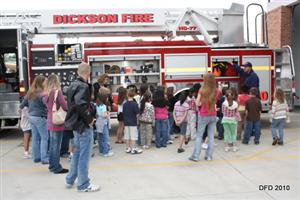
Fire Prevention
Fire Prevention
The City of Dickson Fire Department is committed to the development and implementation of comprehensive proactive programs and procedures, which anticipate, recognize and assess fire risks and initiate actions to remove or reduce those fire risks.
Although fire prevention is a fundamental responsibility of every departmental employee, the fire prevention division is specifically charged with the responsibilities of planning and coordinating fire prevention programs to inform, educate and to assist citizens in becoming more fire prevention/fire reduction oriented.
The City of Dickson Fire Department places an emphasis on fire prevention programs and encourages citizen participation. This concept in enhanced by promoting citizens involvement through fire prevention programs.
Smoke Detectors: Ionization or Photoelectric?
- Ionization
Ionization detectors contain a tiny mass of Americium-241, which is a source of alpha radiation. The principle of using a small amount of radioactive material to ionize the air between two differently charged electrodes is to sense the presence of smoke particles. The radiation passes through an ionization chamber, which is in an air-filled space between two electrodes, and permits a small constant current to flow between the electrodes. Any smoke that enters the chamber absorbs the alpha particles which reduces the ionization and interrupts this flow of current, setting off the alarm.
- Less expensive than photoelectric
- Can detect particles of smoke too small to be visible
- Warns when batteries are to low or failing
- Better response to flaming fires than photoelectric
- Photoelectric
Photoelectric detectors use the principle of utilizing a light source and a photosensitive sensor. When smoke particles enter the light path, some of the light is scattered by reflection and refraction onto the sensor. In other words, when smoke blocks the light beam, the reduction in light reaching the photocell sets off the alarm.
- Uses a light sensor
- Quick to detect slow burning, smoky fires
- Less sensitive to false alarms from cooking and bathroom steam
- Faster response to smoldering fires
BOTH are effective and must pass the same tests to be certified as a listed Underwriters Laboratory (UL). The number and location of alarms is more important than the type.
Fire Safety Tips:
- Always call 911 in case of an emergency
- In case of fire - GET OUT and STAY OUT
- Any smoke, stay low and crawl to safety
- Stop, drop and roll if your clothes catch on fire
- Test your smoke detectors monthly and change batteries twice per year when you set your clocks
- Never disable a detector by borrowing its battery for another use
- Plan and practice two escape routes with your family and establish a meeting place
- Never leave cooking unattended
- Put a lid on a grease fire, never use water
- Never use an appliance with a frayed cord
- Keep lighters, matches and medications away from children
- Keep heaters away from curtains and furniture
- Remove lint from dryer regularly
- Purchase a fire extinguisher and learn how to use it
- Always turn pot handles toward the center of the stove
- Never fill a gasoline container while in vehicle; always place it on ground to fill
- Never store flammable lliquids in your house or garage
- Never wear loose clothing while cooking
- Never run a heater's cord or extension cord under a rug, carpet or furniture
Contact Information
City of Dickson
600 East Walnut Street
Dickson, TN 37055
615-441-9508
Copyright ©2024 City of Dickson, Tennessee
Website Designed by Kimberly Givens DIY


